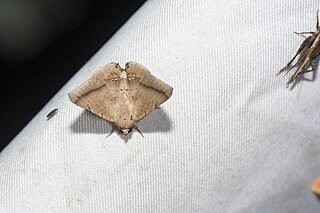Related Research Articles

Colotis vestalis, the white Arab, is a small butterfly of the family Pieridae, that is, the yellows and whites, which is found in India, Pakistan, Iran, Somalia, Ethiopia, Sudan, Kenya and Tanzania. It has a wingspan of 4–5 cm.
Phricogenes is a genus of moths in the family Gelechiidae. It contains the single species Phricogenes sophronopa, which is found in New Guinea.

Thyas coronata is a species of moth of the family Noctuidae first described by Johan Christian Fabricius in 1775. It is found from the Indo-Australian tropics of southern China, Taiwan, Japan, Nepal, India, Sri Lanka to Micronesia and the Society Islands.
Ophiusa disjungens, the guava moth, is a moth of the family Erebidae. The species was first described by Francis Walker in 1858. It is found in south-east Asia and the south Pacific, including Thailand, Japan, Tonga and New South Wales and Queensland. The adult is a fruit piercer.

Macaldenia palumba is a moth of the family Noctuidae first described by Achille Guenée in 1852. It is found from the Oriental region of India, Sri Lanka to Japan (Okinawa) and Sundaland, east to New Guinea. It is also found on Guam in Micronesia.

Trabala vishnou, the rose-myrtle lappet moth, is a moth of the family Lasiocampidae. It is found in south-east Asia, including India, Thailand, Sri Lanka, Myanmar, Java, China, Japan, Hong Kong, and Indonesia. Four subspecies are recognized.
Hypena iconicalis is a moth in the family Noctuidae first described by Francis Walker in 1859. It is found in India, Sri Lanka, Taiwan, Papua New Guinea and Fiji.
Asterolepis glycera is a species of moth of the family Tortricidae. It is found in Australia, where it has been recorded from Queensland.
Hypatima zesticopa is a moth in the family Gelechiidae. It was described by Meyrick in 1929. It is found in North America, where it has been recorded from the Texas and New Mexico.
Anarsia anthracaula is a moth in the family Gelechiidae. It was described by Meyrick in 1929. It is found on the New Hebrides.
Arogalea albilingua is a moth of the family Gelechiidae. It is found in Mexico (Guerrero).
Ardozyga cosmotis is a species of moth in the family Gelechiidae. It was described by Edward Meyrick in 1904. It is found in Australia, where it has been recorded from Western Australia.
Parachronistis destillans is a moth of the family Gelechiidae. It is found in India (Assam).
Recurvaria pleurosaris is a moth of the family Gelechiidae. It is found in Brazil (Amazonas).
Epimimastis emblematica is a moth in the family Gelechiidae. It was described by Meyrick in 1916. It is found in India (Assam).
Agriophara parilis is a moth of the family Depressariidae. It is found in New Guinea.
Lecithocera acolasta is a moth in the family Lecithoceridae. It was described by Edward Meyrick in 1919. It is found in southern India.
Stenoma ambiens is a moth in the family Depressariidae. It was described by Edward Meyrick in 1922. It is found in French Guiana.
Chlamydastis leucoptila is a moth in the family Depressariidae. It was described by Edward Meyrick in 1918. It is found in French Guiana and Guatemala.
Chlamydastis melanonca is a moth in the family Depressariidae. It was described by Edward Meyrick in 1915. It is found in Guyana.
References
| This article on a moth of the subfamily Symmocinae is a stub. You can help Wikipedia by expanding it. |